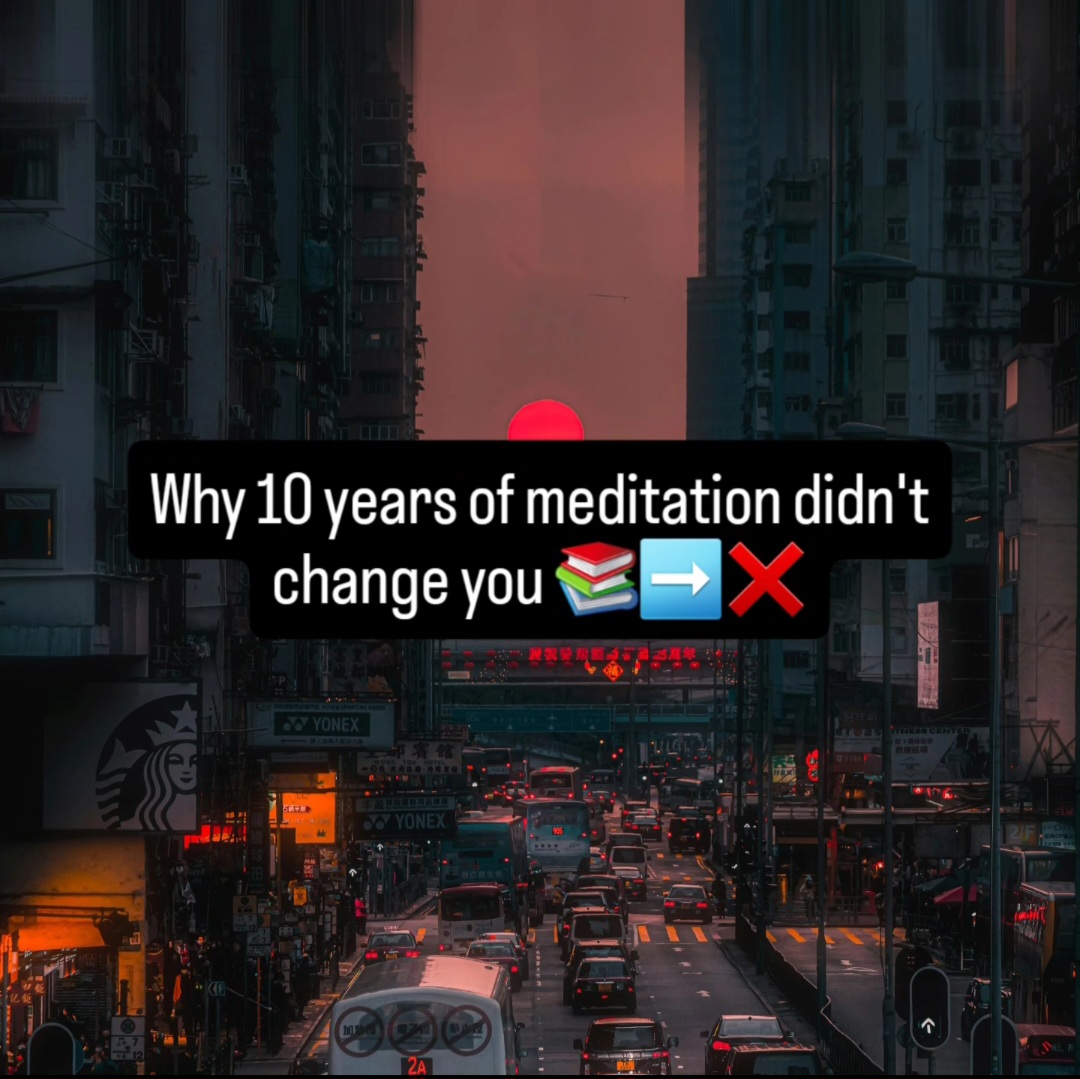The higher centers—Gurdjieff’s term for dormant levels of consciousness beyond ordinary thinking and feeling—remain non-functional in most humans. Unlike refined states of normal awareness, the higher emotional center and higher intellectual center operate with different substances at vastly faster speeds, providing access to awakening that ordinary consciousness cannot reach.
This guide explains what higher centers actually are, why they stay inactive, and what Fourth Way practices might activate them.
Key Points:
- Higher centers ≠ refined ordinary consciousness
- Require specific “hydrogens” (substances) to function
- Self-remembering and conscious suffering are essential practices
- Most “spiritual awakening” is actually lower center experiences
The Critical Distinction Most Seekers Miss
Most accounts of spiritual awakening describe experiences occurring in ordinary centers of consciousness operating under unusual conditions—not the activation of higher centers that remain dormant in virtually all human beings.
The person who has a profound meditation experience, who feels overwhelming love during prayer, who achieves mental clarity after a retreat—these are the lower emotional and intellectual centers having exceptional experiences, not the higher emotional and higher intellectual centers beginning to function.
The difference is not merely degree but kind.
The higher centers operate with different substances, at different speeds, and provide access to states of being that ordinary consciousness cannot reach regardless of how refined or elevated its experiences become.
Why This Matters
This distinction is crucial because widespread confusion between refined lower center functioning and actual higher center activation produces the illusion of awakening that prevents genuine awakening.
The practitioner mistakes an unusually clear thought for higher intellectual functioning, or an experience of devotional love for higher emotional activation, and stops there—convinced they have arrived when they have merely had a preview from a different floor of the same building.
Understanding what the higher centers actually are, why they remain non-functional in ordinary people, and what might allow them to activate constitutes essential knowledge for anyone pursuing genuine transformation rather than merely interesting experiences.
What Are the Higher Centers? Gurdjieff’s Seven Centers of Consciousness
Gurdjieff’s teaching describes human beings as having seven centers of consciousness—five that function ordinarily, and two that remain dormant in most people.
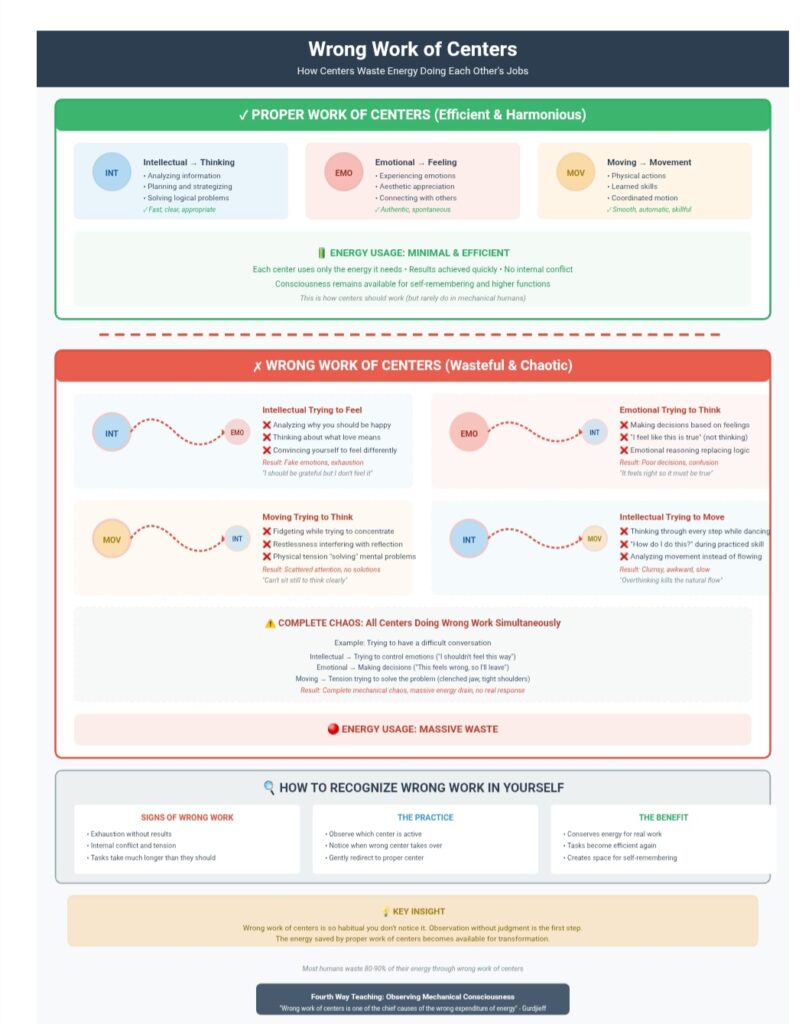
The Five Ordinary Centers
The centers that operate in normal consciousness include:
- Intellectual center (thinking and reasoning)
- Emotional center (feeling and emotional responses)
- Moving center (voluntary movement and learned motion)
- Instinctive center (involuntary functions and reflexes)
- Sex center (sexual energy and attraction)
Each center has its own intelligence, its own memory, its own proper function.
Most people’s centers operate chaotically—the intellectual center trying to feel, the emotional center trying to think, the moving center attempting to solve problems better handled intellectually. This chaos, called “wrong work of centers,” consumes enormous energy while producing minimal results.
The Two Higher Centers
Beyond these five exist the higher emotional center and the higher intellectual center.
These are not “higher” in the sense of being more developed versions of the ordinary emotional and intellectual centers. They are entirely different organs operating with different substances at different speeds.
Here’s the crucial point: They exist and function continuously but remain inaccessible because ordinary consciousness lacks the refined substances (called “hydrogens” in Fourth Way terminology) necessary to receive their transmissions.
Think of it like having a radio that can only receive AM frequencies trying to pick up FM stations—the broadcasts occur continuously but cannot be heard because the receiver lacks necessary equipment.
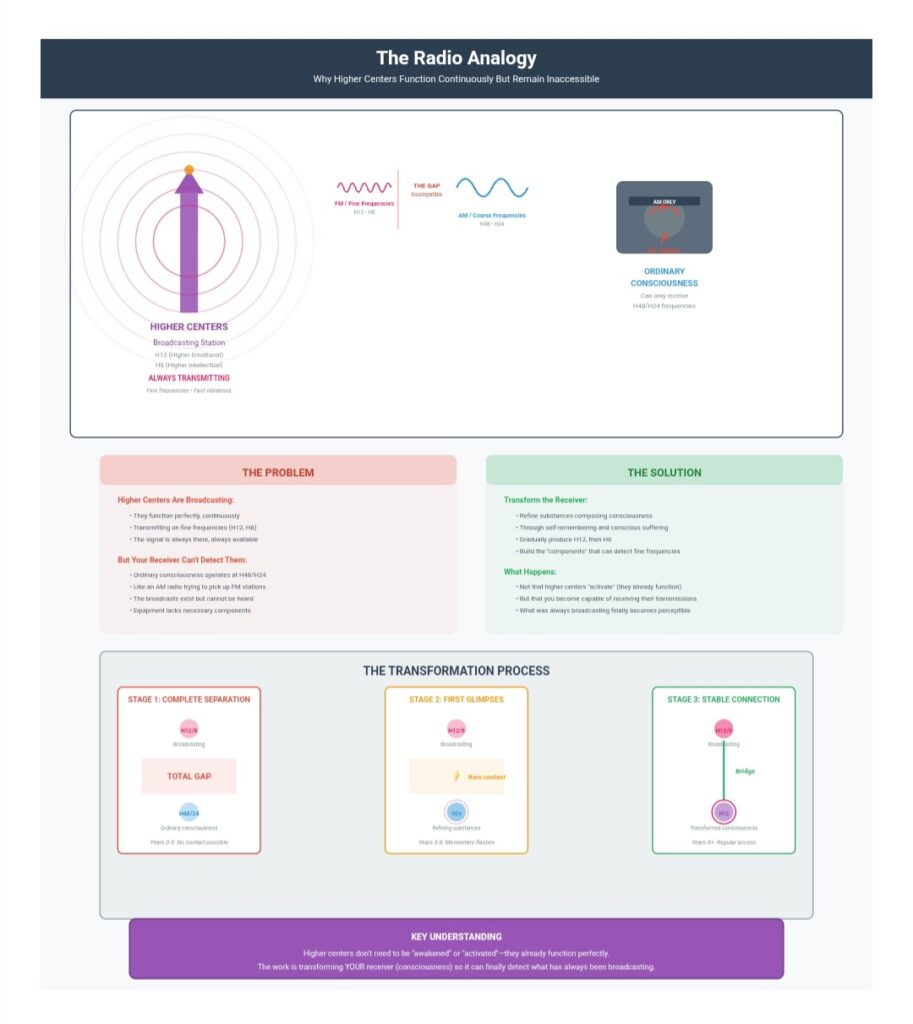
Understanding Higher Centers in Traditional Terms
In traditional metaphysical terms, the ordinary centers correspond to what René Guénon describes as formal manifestation—the domain of individuality conditioned by form, operating within the limitations of space and time.
The higher centers provide access to formless or supra-individual states—domains of being that transcend individual limitations while remaining accessible to consciousness that has developed the capacity to function at those levels.
This is not metaphor but description of ontological reality: human beings exist simultaneously across multiple states of being, but ordinary consciousness remains trapped in the most limited, unable to access states that nonetheless constitute its own deeper reality.
The Higher Emotional Center
The higher emotional center corresponds to what various traditions call:
- The psychic being (Sri Aurobindo)
- The soul or spiritual heart (not the physical organ or even emotional feeling)
- The spiritual center that carries the individual’s essential being across lifetimes
- The seat of aspiration and devotion to what transcends ego
This is not ordinary emotion elevated—it’s an entirely different faculty that experiences states impossible for ordinary emotional consciousness.
The Higher Intellectual Center
The higher intellectual center corresponds to:
- Buddhi in Vedanta—the Intellect (capitalized to distinguish from ordinary intellection)
- The faculty that apprehends universal principles directly rather than through discursive reasoning
- The nous of Plotinus—the organ of direct knowledge
- What Guénon emphasizes as fundamentally different from raison (reason), which can only work with concepts derived from sensory experience
This is the faculty of direct knowing, not reasoning or deduction.
Why Higher Centers Don’t Function: The Hydrogen Explanation
The Fourth Way teaching provides an unusually precise account of why higher centers remain inaccessible: ordinary consciousness operates with hydrogens too coarse to connect with their functioning.
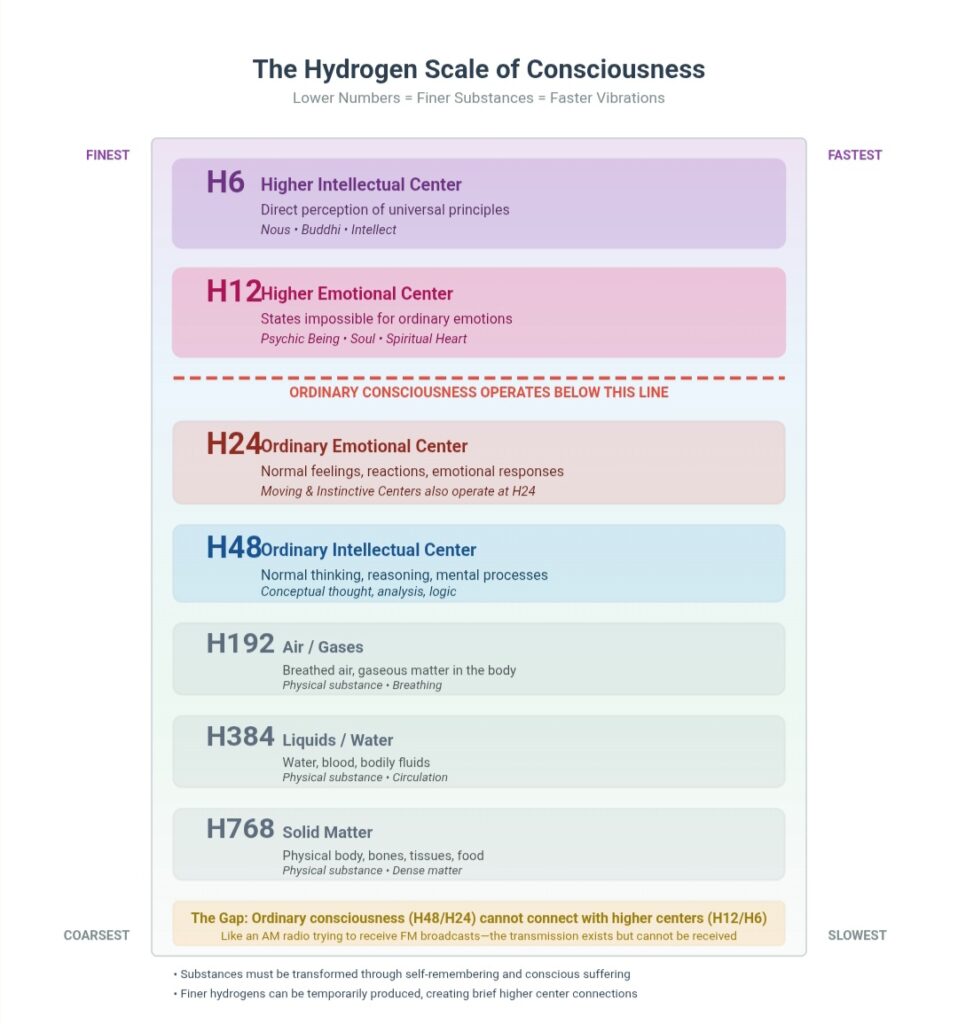
Understanding Hydrogens in Fourth Way Teaching
Everything in the universe consists of matter at different densities or rates of vibration, designated by numbers—the lower the number, the finer the substance and faster the vibration.
Ordinary consciousness operates with:
- Physical body: Hydrogen 768 (solid matter), 384 (liquids), 192 (gases)
- Ordinary thoughts: Hydrogen 48
- Ordinary emotions: Hydrogen 24
Higher centers require:
- Higher emotional center: Hydrogen 12
- Higher intellectual center: Hydrogen 6
These substances are so much finer and faster than what fills ordinary consciousness that no connection can occur.
Why Higher Centers Function But Can’t Be Accessed
The higher centers function continuously—they are not dormant in the sense of being asleep or inactive—but their transmissions cannot be received by consciousness that consists of much coarser substances.
Occasionally, through accident or intense practice, enough H12 or H6 may be produced momentarily for a flash of higher center functioning to break through into ordinary awareness.
The person has what they call a spiritual experience, a moment of awakening, a glimpse of something beyond ordinary consciousness. But such experiences are temporary precisely because the substances that made them possible were temporary.
The Principle of Correspondence
Traditional metaphysics describes the same principle through the doctrine of correspondence: the microcosm must be constituted of substances corresponding to what it seeks to know in the macrocosm.
- To know formal, individual states → consciousness composed of gross matter suffices
- To know formless, universal states → consciousness must be composed of substances fine enough to register those states
This is why Guénon insists that metaphysical realization—knowledge of principles that transcend form—cannot occur through ordinary mental faculties (manas) but requires activation of Intellect (Buddhi), which itself operates at the formless level and can therefore know formless reality directly.
The Devastating Practical Implication
No amount of ordinary thinking, no matter how refined or sophisticated, can access what the higher intellectual center knows.
No amount of ordinary emotion, no matter how elevated or devotional, can feel what the higher emotional center feels.
The gap is not quantitative but qualitative.
You cannot think your way to Intellect or feel your way to the psychic being using ordinary faculties. The substances must be transformed.
3 Obstacles Blocking Higher Center Activation
Even if finer substances were present, three fundamental obstacles prevent their use: identification, imagination, and lying.
These are not moral failings but mechanical features of how ordinary consciousness operates, and they must be understood clearly because they consume the very substances that could potentially connect with higher centers.
Obstacle 1: Identification
Identification is complete absorption into whatever captures attention—a thought, emotion, sensation, person, situation.
When identified, there is no “I” observing the experience; there is only the experience happening. You become the anger, the worry, the pleasure, the offense.
This complete immersion consumes all available energy, leaving none for self-observation or self-remembering.
Traditional terms for identification include:
- Avidyā (ignorance) in its root sense—not knowing the Self
- Mistaking modifications of consciousness for consciousness itself
- The jīva forgetting it is Ātman
Why Identification Blocks Higher Centers
Identification prevents higher center functioning because higher centers require a certain quality of attention—divided attention, self-remembering, consciousness aware of itself while experiencing.
In identification, consciousness loses itself entirely in its object. Even if H12 or H6 were present, they would be immediately consumed by the mechanical identification that characterizes ordinary consciousness.
This is why most spiritual experiences, however profound, change nothing permanently—they occur during a rare moment when identification temporarily lifted, but when identification returns (which it immediately does), the experience becomes mere memory, feeding the ego rather than transforming it.
Obstacle 2: Imagination
Imagination in Gurdjieff’s use does not mean creativity but the continuous internal cinema—daydreaming, fantasizing, the endless internal dialogue, thinking about oneself, rehearsing conversations, replaying grievances.
This mechanical imagination consumes vast quantities of energy while producing nothing real. It is the noise that prevents hearing higher center transmissions.
Traditional teachings call this:
- The wandering mind
- The monkey mind
- The stream of vṛttis (thought-waves) that Patanjali says must be stilled for yoga to occur
The False Sense of Inner Life
The person immersed in imagination believes they are thinking, feeling, observing—but they are merely watching the mechanical unfolding of conditioned associations.
Real thinking (higher intellectual center) and real feeling (higher emotional center) are entirely different from this mechanical churning.
But the mechanical process is so continuous and familiar that it is mistaken for consciousness itself. Imagination creates a false sense of inner life that prevents recognition of how empty ordinary consciousness actually is.
Obstacle 3: Lying
Lying—both to others and especially to oneself—creates buffers that prevent seeing things as they are.
The lie is not always deliberate falsehood but any departure from what one actually observes:
- Any substitution of how things should be for how they are
- Any justification that obscures reality
- Any self-deception about one’s true state
How Buffers Prevent Transformation
Buffers are psychological mechanisms that prevent contradictory aspects of oneself from coming into contact—allowing one to:
- Hold incompatible beliefs
- Claim values while acting against them
- Think oneself one way while being entirely different
These buffers prevent self-knowledge, and without self-knowledge there can be no transformation.
Traditional paths emphasize:
- Self-inquiry (ātma-vicāra)
- Self-examination (Christian tradition)
- Continuous self-observation
All aim to penetrate the layers of self-deception that prevent seeing what one actually is. This is not psychological analysis but direct observation of the mechanical nature of ordinary consciousness, which is prerequisite to anything beyond mechanical consciousness.
How to Activate Higher Centers: Self-Remembering Practice
The primary practice Gurdjieff taught for creating conditions that might allow higher center connection is self-remembering—divided attention in which consciousness is aware simultaneously of object and subject, of what is experienced and the one experiencing.
What Self-Remembering Is
In ordinary consciousness, attention flows entirely outward:
- I see the tree
- I hear the sound
- I think the thought
In self-remembering, attention divides:
- I am aware of the tree and aware of myself seeing the tree
- I am aware of the thought and aware of myself thinking
- I experience the emotion and remain aware that “I” am experiencing
The State Self-Remembering Creates
This divided attention creates a different quality of presence, what Ouspensky calls “a state of heightened consciousness” in which one exists more fully than in ordinary waking sleep.
More importantly, self-remembering produces, under certain conditions, a temporary appearance of finer substances (H12 or H6) that can potentially connect with higher centers.
This is not guaranteed—the substances may be consumed by identification or imagination before connection occurs—but it creates the possibility that did not exist in mechanical consciousness.
Parallel Practices in Other Traditions
Traditional teachings describe parallel practices:
- The cultivation of sākṣī-bhāva (witness consciousness) in Vedanta
- Mindfulness (sati) in Buddhism
- The Christian practice of presence of God
- Sufi muraqaba (vigilance)
All aim to establish a consciousness that observes without identifying, that remains present to itself while experiencing, that creates the space in which something higher than ordinary consciousness might function.
The Subtle Point About Self-Remembering
Here the teaching becomes subtle and easily misunderstood.
Self-remembering is not itself the functioning of higher centers but the creation of conditions in which their functioning might be received.
The higher centers already function—continuously, perfectly—but their transmissions cannot penetrate the static of identification, imagination, and lying that fills ordinary consciousness.
When self-remembering temporarily quiets this static, when the production of finer substances creates a momentary connection, then for an instant the higher centers’ perpetual functioning becomes perceptible to ordinary awareness.
Grace vs. Effort
This is why genuine spiritual experiences are always described as grace, as something received rather than achieved.
From the perspective of ordinary consciousness making efforts, the experience seems to be caused by practice.
From the perspective of higher centers always functioning and occasionally finding an opening to transmit into ordinary awareness, the experience is simply recognition of what was always there.
Both descriptions are true at different levels.
The Law of Octaves: Why Transformation Processes Fail Without Shocks
Before understanding how to apply specific practices, you must understand why all transformation processes—including the development necessary for higher center activation—follow a universal pattern that guarantees failure at predictable points unless conscious intervention occurs.
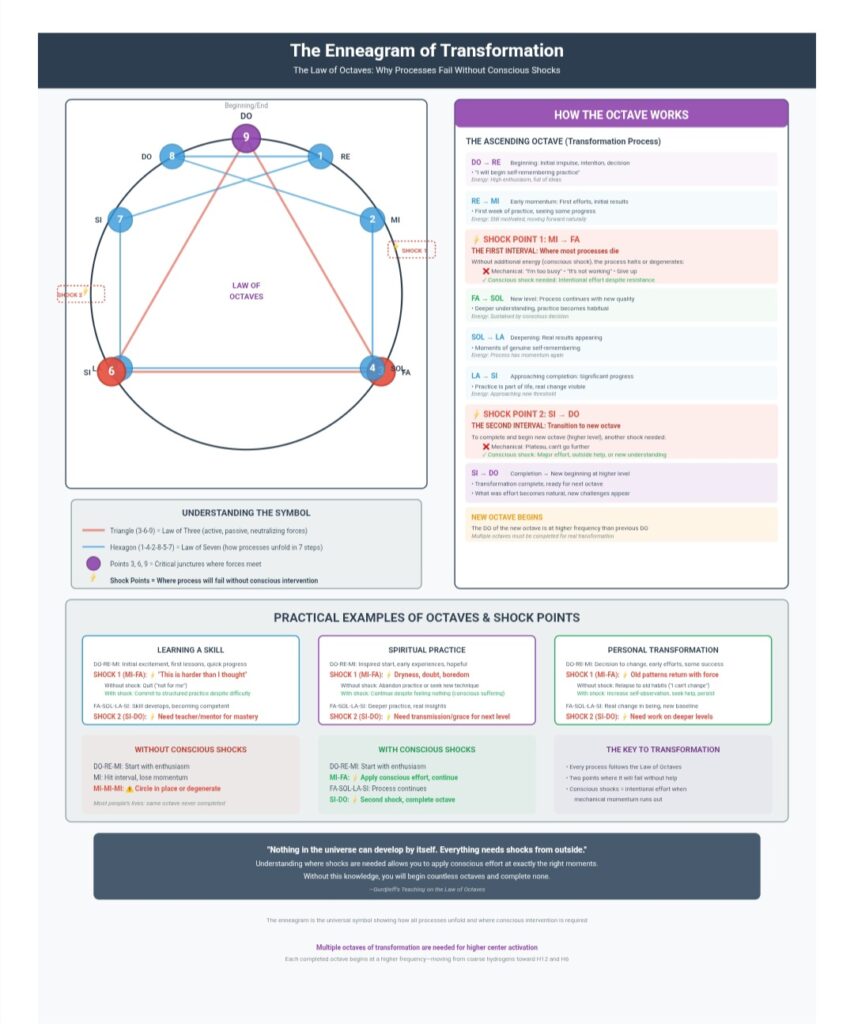
Gurdjieff taught that nothing in the universe develops continuously on its own. Every process, whether physical, psychological, or spiritual, follows what he called the Law of Octaves—a pattern of development that proceeds in seven distinct stages but requires external shocks at two critical points to continue. Without these shocks, the process either stops entirely or deviates into something unintended.
This is not metaphor or philosophy—it describes an observable pattern in how energy moves through any system attempting transformation.
Understanding the Enneagram and Musical Octave
The enneagram—Gurdjieff’s symbol showing a circle with nine points connected by specific inner lines—maps how this law operates. The process moves through seven notes of a musical octave: DO-RE-MI-FA-SOL-LA-SI-DO.
The movement proceeds naturally through most stages:
- DO → RE: Initial impulse, beginning with enthusiasm
- RE → MI: Early momentum, first efforts show results
- FA → SOL: Renewed development after first shock
- SOL → LA: Deepening of the process
- LA → SI: Approaching completion
But two intervals require external energy:
Between MI and FA is the first critical interval—what musicians call the half-step where no black key exists on a piano. Here, the natural momentum runs out. Without additional energy from outside the process, development halts or circles back on itself.
Between SI and DO is the second interval—the transition point to complete the octave and begin a new one at a higher level. Again, natural momentum is insufficient. An external shock is required.
These aren’t arbitrary points—they represent actual moments where the energy maintaining the process becomes too refined to continue on its own. The process needs an influx of coarser energy to bridge the gap.
The Two Shock Points: Where Everything Falls Apart
First Shock Point (MI-FA): Where Most Processes Die
This interval appears early, usually after initial enthusiasm fades and difficulty becomes apparent. This is where:
- New Year’s resolutions collapse (February)
- Meditation practices are abandoned (after first retreat high wears off)
- Business ventures fail (year 2-3 when startup energy exhausted)
- Relationships end (when infatuation gives way to seeing the actual person)
- Spiritual seekers switch to a new teacher or technique
The mechanical person reaches this point and interprets the loss of momentum as evidence that the process was wrong, not for them, or has failed. “It’s too hard.” “I’m not getting anywhere.” “This isn’t working.” These are the mechanical mind’s interpretations of hitting the first interval.
What’s actually happening: The coarse energy that began the process (enthusiasm, novelty, hope) has refined itself through DO-RE-MI and can no longer maintain forward movement on its own. The process needs a conscious shock—an intentional input of energy that wasn’t naturally present.
Second Shock Point (SI-DO): Transition to New Octave
The second interval appears later, when significant development has occurred but cannot complete without outside help. This is where:
- Skilled practitioners plateau and cannot advance further alone
- Spiritual practices produce results but cannot breakthrough to the next level
- Personal transformation reaches its limit without external transmission
- Understanding remains intellectual and cannot penetrate to being
What’s actually happening: The process has refined energy through six stages but lacks what’s necessary to complete the octave and begin the next one at a higher frequency. This typically requires something the practitioner cannot provide themselves—a teacher, a teaching, an external circumstance, what traditions call grace.
Why This Matters for Higher Center Activation
The transformation of substances necessary for higher center connection requires completing multiple octaves—each one moving consciousness from coarser to finer hydrogens.
Why This Matters for Higher Center Activation
The transformation of substances necessary for higher center connection requires completing multiple octaves—each one moving consciousness from coarser to finer hydrogens.
One octave might move you from complete mechanical sleep to moments of self-remembering. The next octave transforms those moments into sustained periods of divided attention. The next produces occasional flashes of H12 (higher emotional center contact). Years more might be required for stable H12 connection. Decades for H6 (higher intellectual center).
Each octave has two shock points where you will fail without conscious intervention.
This is why casual practice produces nothing. The person meditates for a few weeks (DO-RE-MI), hits the first interval when enthusiasm fades, interprets this as “meditation not working,” and quits. They never apply the conscious shock—the decision to continue despite the loss of natural momentum—necessary to reach FA and continue developing.
This is why many longtime practitioners never transform. They may have passed the first shock point through discipline or fortunate circumstances, but they practice within a single octave indefinitely, never receiving the second shock necessary to complete and begin the next octave at a higher level.
Practical Examples of Octaves in Inner Work
Example 1: Beginning Self-Remembering Practice
- DO-RE-MI: You decide to practice self-remembering. First days bring novel experiences—moments of actually being present, seeing yourself mechanically, feeling something different than ordinary consciousness. Exciting, promising.
- First Interval (MI-FA): Week three. Self-remembering feels impossible, mechanical. You forget for hours, even days. When you remember, nothing special happens. The practice seems pointless.
- Without conscious shock: Abandon practice. “I must be doing it wrong” or “This doesn’t work for me.”
- With conscious shock: Continue anyway. Increase efforts despite no results. Study the teaching more deeply. Contact others practicing. The decision to persist IS the shock.
- FA-SOL-LA-SI: Practice becomes habitual. Moments of real self-remembering increase. You begin to see the depth of mechanical consciousness. Real understanding develops.
- Second Interval (SI-DO): You’ve developed capacity for self-remembering but cannot go deeper alone. Mechanical understanding has become conscious understanding, but something more is needed for understanding to transform being.
- Without conscious shock: Plateau. Continue practicing but make no further progress. Become a sophisticated sleeper.
- With conscious shock: Seek a teacher, teaching, or group that can provide what you cannot. Find work on deeper aspects—emotional center, sexual center, transformation of negative emotions. Or circumstances create the necessary friction.
Example 2: Working with Conscious Suffering
- DO-RE-MI: You begin trying to bear discomfort without complaint. First efforts are impressive to ego—you handle irritation, minor pain, frustration without expressing them. Feel proud of this new capacity.
- First Interval: Real suffering appears—serious pain, betrayal, loss. All capacity for conscious suffering disappears. Complete identification returns. You complain, justify, dramatize exactly as before.
- Without shock: Conclude conscious suffering only works with small difficulties. Return to mechanical suffering when it matters.
- With shock: Recognize this as the interval. Apply maximum effort exactly when it seems impossible. This is when the practice actually begins.
- Second Interval: Conscious suffering has become possible even in difficult circumstances. But to transform suffering into the alchemical heat that actually refines substances—not just endure it—requires understanding you don’t yet have.
- Without shock: Continue bearing suffering well but producing no transformation. Become stoic but not transformed.
- With shock: Something reveals how to suffer consciously in a way that actually transmutes substances. This cannot be figured out—it must be shown.
How to Recognize Where You Are in an Octave
Most people cannot tell where they are because they’ve never completed a single octave in anything—they quit at the first interval every time, or they circle within one octave indefinitely.
Signs you’re at the first interval (MI-FA):
- Natural enthusiasm has disappeared
- Practice feels mechanical, effortless progress has stopped
- Doubt appears: “Is this the right path?”
- Strong temptation to switch to something new
- Internal justifications for quitting arise
Signs you’re at the second interval (SI-DO):
- Significant development has occurred
- You’ve plateaued—continuing practice produces no new results
- Sense of having gone as far as you can alone
- Understanding remains incomplete despite years of work
- Something is needed that you cannot provide yourself
Signs you’re circling without completing octaves:
- Years of practice with no fundamental change in being
- Can describe the teaching perfectly but don’t embody it
- Refined lower center functioning mistaken for transformation
- Spiritual sophistication that impresses others but hasn’t freed you
The Conscious Application of Shocks
You cannot provide your own shocks at the second interval—this requires external input, though you must create conditions that make such input possible. But you can provide conscious shocks at the first interval, and this is where most inner work occurs.
The first conscious shock is the decision to continue when natural momentum has stopped.
Not because you feel like it. Not because it’s working. Not because you’re seeing results. Simply because continuing is what the work requires. This intentional application of effort when mechanical energy has run out is the shock that allows MI to pass to FA.
Most people apply effort enthusiastically when energy is high (DO-RE-MI) and quit when it becomes difficult (at the interval). This produces nothing. The person who applies effort especially when it’s difficult, when nothing seems to be working, when every mechanical part wants to quit—this person provides the shock that allows the octave to continue.
This is why sustained practice over years matters: Not because time automatically produces results, but because years of practice include dozens or hundreds of opportunities to hit the first interval and consciously choose to continue. Each time you apply the shock successfully, the octave advances. Each time you quit or drift into mechanical practice, the octave fails or circles.
Why Understanding This Prevents Wasted Effort
If you don’t understand the Law of Octaves, you will interpret the first interval as evidence of failure rather than recognizing it as the precise point where conscious work can begin. You will quit, switch practices, seek new teachers, or conclude you’re not suited for inner work—when actually you reached the only point where the practice could start producing real results if you continued.
If you don’t understand the second interval, you will either remain trapped in a single octave indefinitely (becoming a sophisticated practitioner who never transforms) or waste years seeking externally what must come from within when you’re actually at a point where external help is genuinely needed.
The teaching is ruthlessly precise: Multiple octaves must be completed to produce even momentary higher center contact. Each octave takes months to years depending on the work involved. Each has two points where conscious shocks are required. Most people complete zero octaves in their entire lives because they quit at the first interval every time.
Understanding this doesn’t make the work easier—it makes it possible. Without this knowledge, you’re attempting transformation blindfolded, unable to distinguish between genuine difficulty that must be worked through and pointless suffering that should be abandoned. With this knowledge, the intervals become visible as opportunities rather than obstacles.
Conscious Suffering: Transforming Substances for Higher Awareness
Self-remembering creates possibility but does not guarantee higher center connection. A second essential practice Gurdjieff taught is conscious suffering—the intentional bearing of difficulty, friction, discomfort without the usual mechanical reactions of complaint, justification, or escape.
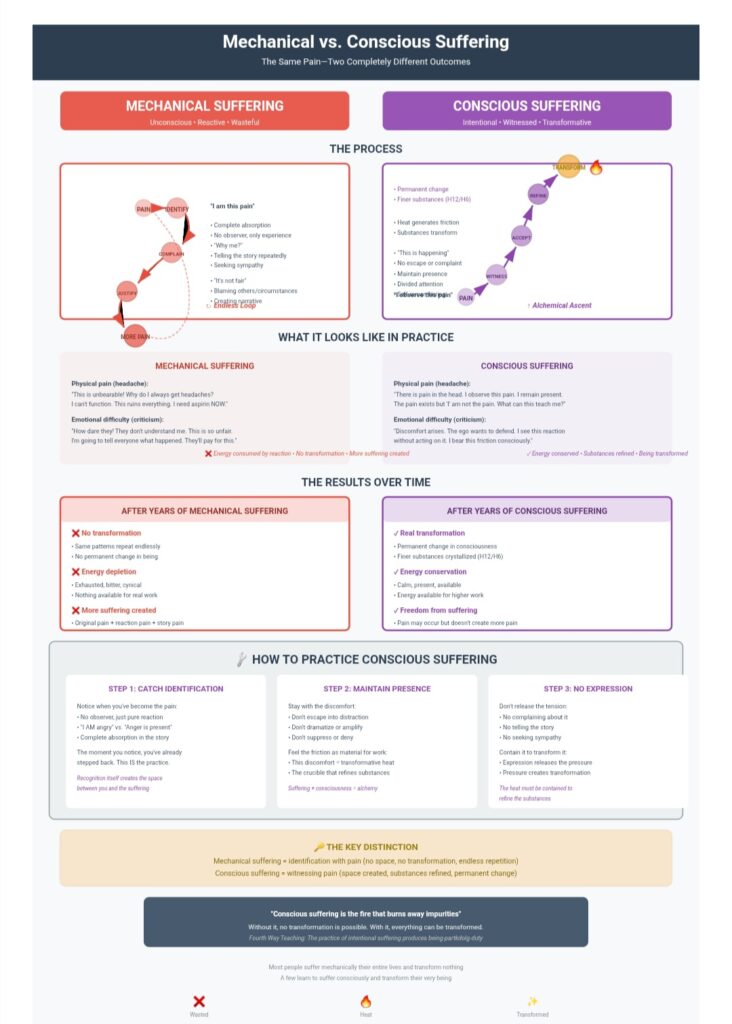
Mechanical vs. Conscious Suffering
Mechanical suffering:
- Unconscious identification with pain
- Emotional reaction to difficulty
- Dramatization of discomfort
- Consumes energy without producing anything useful
- Suffering that merely happens to one
- Its only product is more suffering
Conscious suffering:
- Witnessing pain while maintaining presence
- Accepting difficulty without complaint
- Enduring friction without identifying with the discomfort
- Generates what Fourth Way calls being-partkdolg-duty
- The heat or friction that refines coarse substances into finer ones
The Alchemical Effect
This produces alchemical effect: it transforms substances.
Traditional teachings describe this as tapas—the transformative heat generated through:
- Discipline
- Austerity
- Effort sustained without attachment to results
It is the fire that burns away impurities, the crucible of alchemical transformation.
Aurobindo speaks of it as the transforming pressure that forces consciousness to exceed its current limitations.
The principle is consistent: transformation requires friction, and friction requires choosing difficulty rather than comfort, maintaining presence rather than escaping into mechanical reactions.
The Nature of These Substances
The substances this produces—the refined hydrogens that might connect with higher centers—are not metaphorical but actual, though “substance” here includes what Western materialism cannot recognize: the subtle matter of which emotions, thoughts, and consciousness itself consist.
When Gurdjieff speaks of producing H12 or H6, he means actual transformation of the matter composing consciousness, not mere psychological change.
This is why he insisted genuine work is crystallization—the formation of a permanent “I” composed of substances fine enough to survive the death of the physical body.
The Subtle Body and Survival After Death
Traditional metaphysics expresses this through the doctrine of the subtle body (sūkṣma śarīra)—not the gross physical body but the vehicle composed of subtler substances that persists beyond physical death if it has been sufficiently developed and crystallized during life.
Related teachings across traditions:
- The bardo teachings in Tibetan Buddhism
- The Islamic teachings on barzakh (the intermediate state)
- The Christian doctrine of the resurrection body
All refer to this principle: certain development during life is necessary for consciousness to continue in coherent form after death.
Without it, individual consciousness dissolves back into cosmic consciousness like a wave subsiding into ocean.
Knowledge and Being: Why Understanding Changes Nothing
Before examining signs of higher center functioning, you must understand why most spiritual practitioners—despite years of study and practice—exhibit no genuine transformation. The Fourth Way teaching provides precise diagnosis: they have developed knowledge without developing being.
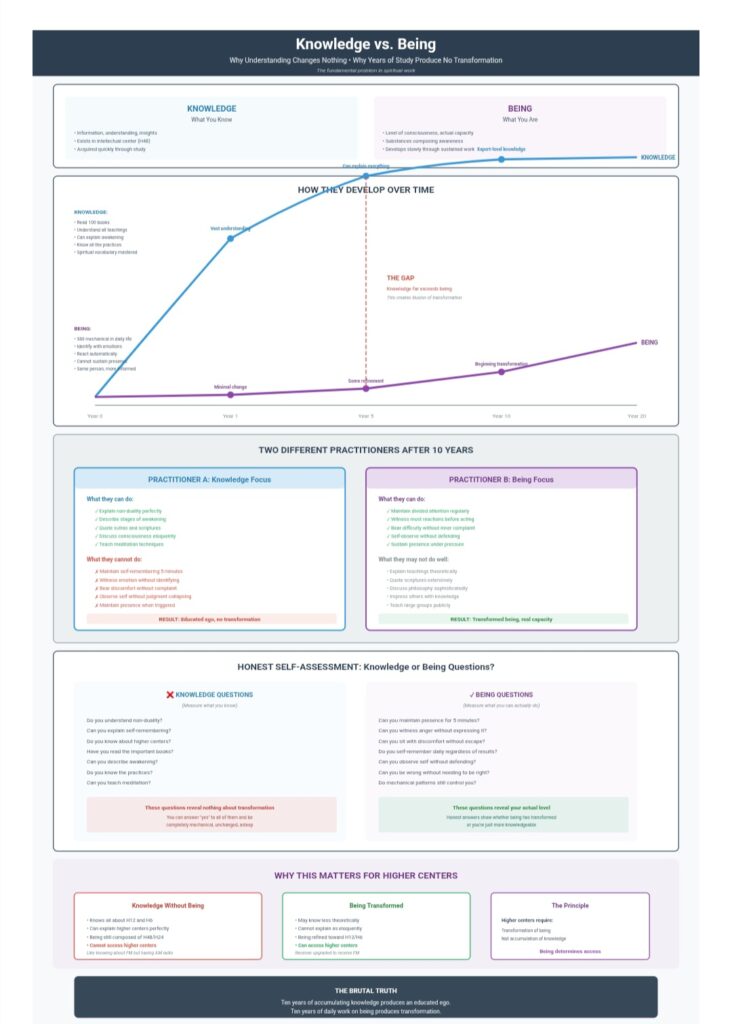
Knowledge is what you know—information, understanding, insight, philosophy, technique. It accumulates in the intellectual center and can be acquired quickly through reading, listening, thinking. You can know the entire teaching intellectually within months.
Being is what you are—the actual level of consciousness, the substances composing your awareness, your capacity to function in states beyond ordinary consciousness. It develops slowly through years of sustained work and cannot be acquired through study alone.
The fundamental problem in spiritual work is that knowledge and being develop independently and at vastly different rates.
The Knowledge-Being Gap
Most spiritual seekers develop knowledge far beyond their level of being. They can:
- Explain non-duality perfectly
- Describe stages of enlightenment in detail
- Quote sutras, scriptures, and sacred texts
- Articulate complex metaphysical principles
- Teach meditation techniques fluently
- Discuss consciousness with sophisticated vocabulary
But they cannot:
- Sustain self-remembering for five minutes
- Witness an emotion without identifying with it
- Bear discomfort without complaint
- Observe themselves without judgment collapsing into criticism
- Maintain presence when mechanical patterns are triggered
They know what awakening is but cannot access it because knowledge exists in the intellectual center while awakening requires transformation of being—transformation of the actual substances composing consciousness.
This is not hypocrisy or failure—it’s the natural consequence of how knowledge and being develop. Knowledge advances through study. Being advances through work that transforms substances. These are different processes with different timelines.
Why Knowledge Alone Is Worthless for Transformation
Gurdjieff insisted that knowledge without corresponding being is not merely incomplete—it’s actively harmful because it creates the illusion of understanding without the reality of transformation.
The person with knowledge but no being:
- Believes they understand because they can describe
- Mistakes intellectual grasp for realized truth
- Thinks reading about self-remembering equals practicing it
- Confuses knowing the map with walking the territory
- Stops working because they “already know this”
This is why Gurdjieff said that beyond a certain point, knowledge without being becomes mere information that feeds ego rather than transforms consciousness. The practitioner becomes what he called a “learned fool”—someone who knows everything and can do nothing.
Traditional teachings recognize this same problem:
- Vedanta distinguishes parokṣa-jñāna (indirect knowledge from study) from aparokṣa-jñāna (direct knowledge from realization)
- Buddhism distinguishes intellectual understanding from prajñā (wisdom born of direct insight)
- Christian mysticism distinguishes theology from theosis (actual union with divine)
- Sufism distinguishes ‘ilm (knowledge) from ma’rifa (gnosis/direct knowing)
All traditions recognize: you can know everything about water and die of thirst.
What Development of Being Actually Means
Being develops through transformation of the substances composing consciousness—moving from coarse hydrogens (H48/H24) toward refined hydrogens (H12/H6). This transformation occurs not through study but through sustained practices that generate friction and heat:
Practices that develop being:
- Self-remembering daily regardless of results
- Conscious suffering without expression or complaint
- Self-observation without judgment or justification
- Working through octaves including their difficult intervals
- Bearing friction when every mechanical part wants escape
- Maintaining presence exactly when it seems impossible
What does not develop being:
- Reading books about consciousness
- Attending lectures on awakening
- Discussing philosophy in study groups
- Understanding teachings intellectually
- Collecting techniques and methods
- Memorizing stages of enlightenment
The person focused on knowledge accumulates information. The person focused on being transforms substances. Only the latter produces access to higher centers.
The Relationship Between Being and Higher Centers
Higher centers require substances that ordinary being does not possess. Your current level of being—the substances composing your consciousness—determines what you can access:
Being at H48/H24 level (ordinary consciousness):
- Can know about higher centers intellectually
- Can understand the teaching conceptually
- Cannot access higher center transmissions
- Like AM radio knowing FM exists but unable to receive it
Being refined toward H12 (years of work):
- May have momentary flashes of higher emotional center
- Brief contacts that cannot be sustained or reproduced
- Glimpses that confirm direction but don’t establish stable access
- Like AM radio occasionally picking up fragments of FM signal
Being transformed to H12 level (decade+ of work):
- Regular access to higher emotional center possible
- States of consciousness impossible at lower being-levels
- Permanent change—new baseline, not peak experience
- Like radio upgraded to receive FM—what was impossible is now natural
This is why knowledge helps nothing: Knowing about H12 while being composed of H48/H24 is like knowing about FM radio while being an AM-only receiver. The knowledge is accurate but useless for accessing the frequency. Only transformation of being—upgrading the receiver—makes access possible.
How to Assess Your Actual Level of Being
Most spiritual practitioners vastly overestimate their level of being because they confuse knowledge with actualization. Here are ruthlessly honest criteria:
Signs of undeveloped being (regardless of knowledge):
- Cannot maintain self-remembering through ordinary tasks
- Identify completely with emotions when triggered
- Defend, justify, and explain yourself automatically
- Need to be right in disagreements
- Take offense easily, react mechanically
- Cannot sit with discomfort without distraction
- Dramatic suffering that seeks sympathy
- Strong opinions on everything
- Certain about your insights and understandings
Signs of developing being:
- Can maintain divided attention intermittently
- Witness some emotions without total identification
- Observe mechanical patterns without always acting on them
- Can be wrong without defending
- Less reactivity to ordinary provocations
- Can bear discomfort without expression
- Suffer privately without dramatization
- Uncertainty about what you “know”
- Aware of vast areas of mechanical functioning still operating
Signs of transformed being:
- Sustained self-remembering possible
- Witness most reactions before they manifest
- Mechanical patterns visible but not compelling
- Offense almost impossible—nothing to defend
- Comfort with not knowing
- Bear significant difficulty without inner complaint
- Inner silence without effort
- Certainty about what is directly perceived (not believed)
- Overwhelming awareness of how far you have yet to go
Most people reading this will recognize themselves in the first category despite years of study. This is not failure—it’s diagnostic information. The recognition that knowledge has outpaced being is the beginning of real work rather than mere study.
Why Most Long-Term Practitioners Show No Transformation
The landscape of contemporary spirituality is filled with people who have been “practitioners” for decades yet exhibit no signs of genuine transformation. They remain:
- Reactive and mechanical in daily life
- Identified with thoughts and emotions
- Defensive when challenged
- Seeking validation and recognition
- Unable to maintain presence under pressure
- Sophisticated in explanation but unchanged in being
Why? Because they accumulated knowledge without doing the work that transforms being. They:
- Read extensively but practice minimally
- Attend workshops but don’t work between them
- Understand teachings but don’t apply them daily
- Can describe self-remembering but rarely actually do it
- Know about conscious suffering but avoid all discomfort
- Collect methods rather than working deeply with one
This creates what Gurdjieff called the “tramp”—someone who wanders from teacher to teacher, method to method, always learning new things but never transforming. The knowledge library grows. The being remains static.
The brutal truth: Ten years of collecting knowledge produces an educated ego. Ten years of daily work on being produces transformation. Most choose the former because it’s easier and more immediately gratifying to learn new things than to face your mechanical nature daily without escape.
The Proper Relationship Between Knowledge and Being
Knowledge and being should develop in proportion—like two legs walking. When they become unbalanced, problems arise:
Knowledge far exceeds being:
- Dangerous: Creates spiritual pride and illusion of attainment
- Person believes they’re transformed because they understand transformation
- Knowledge becomes barrier rather than aid
- Common problem in contemporary spirituality
Being develops without knowledge:
- Limiting: Transformation occurs but without understanding
- Person changes but cannot articulate or guide process
- Rare problem (most err on opposite side)
- May waste years exploring blindly
- Knowledge and being develop proportionally:
- Ideal: Understanding illuminates work, work confirms understanding
- Each new insight tested through practice
- Each practice deepens conceptual understanding
- Knowledge guides work; work validates knowledge
The teaching provides knowledge so that work can proceed intelligently rather than blindly. But the knowledge is useful only if it directs actual work on being rather than substituting for it.
Practical Application: From Knowledge to Being
If you recognize knowledge has outpaced being—and if you’re honest, you probably have—what to do?
1. Stop accumulating more knowledge. You already know enough. The problem isn’t insufficient information but insufficient application. Reading another book about consciousness will not help. Practicing self-remembering daily for a year will.
2. Choose one practice and work with it daily. Not collect practices—work with one. Self-remembering or conscious suffering or self-observation. Daily. For months. Through all the intervals where it seems pointless. Until it transforms something.
3. Measure by being, not knowledge. Stop tracking what you’ve learned and start tracking what you can actually do. Can you maintain presence for five minutes? Can you witness anger without expressing it? These are being-questions, not knowledge-questions.
4. Accept that being develops slowly. Knowledge can be acquired in months. Being transforms over years. This timeline offends the part that wants quick results, but that part is precisely what must be transformed through sustained work.
5. Work especially when nothing seems to happen. The intervals in octaves—where natural momentum stops and conscious shocks are needed—are exactly where being develops. Knowledge might say “this isn’t working.” But being develops precisely by continuing when knowledge says stop.
Knowledge, Being, and Higher Centers
Return to the central question: Why do higher centers remain inaccessible despite years of practice and extensive knowledge?
Because higher centers require transformation of being, not accumulation of knowledge.
You can know everything about higher centers—what they are, what substances they require, what states they produce—and access nothing because knowledge exists in the intellectual center operating at H48 while higher centers require consciousness transformed to H12 or H6.
The work is not learning about higher centers but becoming the kind of being that can connect with them.
This is not achieved through:
- Reading Ouspensky perfectly
- Understanding Gurdjieff completely
- Explaining the Fourth Way eloquently
- Knowing all the practices theoretically
This is achieved through:
- Years of daily self-remembering
- Sustained conscious suffering
- Working through countless octave intervals
- Transforming the actual substances composing your awareness
- Building being rather than accumulating knowledge
Most people on the spiritual path are becoming more knowledgeable. Few are becoming different beings. The former produces sophisticated sleep. The latter produces awakening.
The question is not “do you understand?” but “what can you actually do?” Not “do you know about self-remembering?” but “can you maintain divided attention right now for five minutes?” Not “do you know about higher centers?” but “have the substances composing your consciousness transformed?”
These are being-questions. And they admit no clever answers—only direct observation of your actual capacity.
5 Signs Your Higher Centers Are Actually Functioning
Given the prevalence of self-deception in spiritual matters, how can one recognize whether higher centers are actually functioning or merely ordinary centers having unusual experiences?
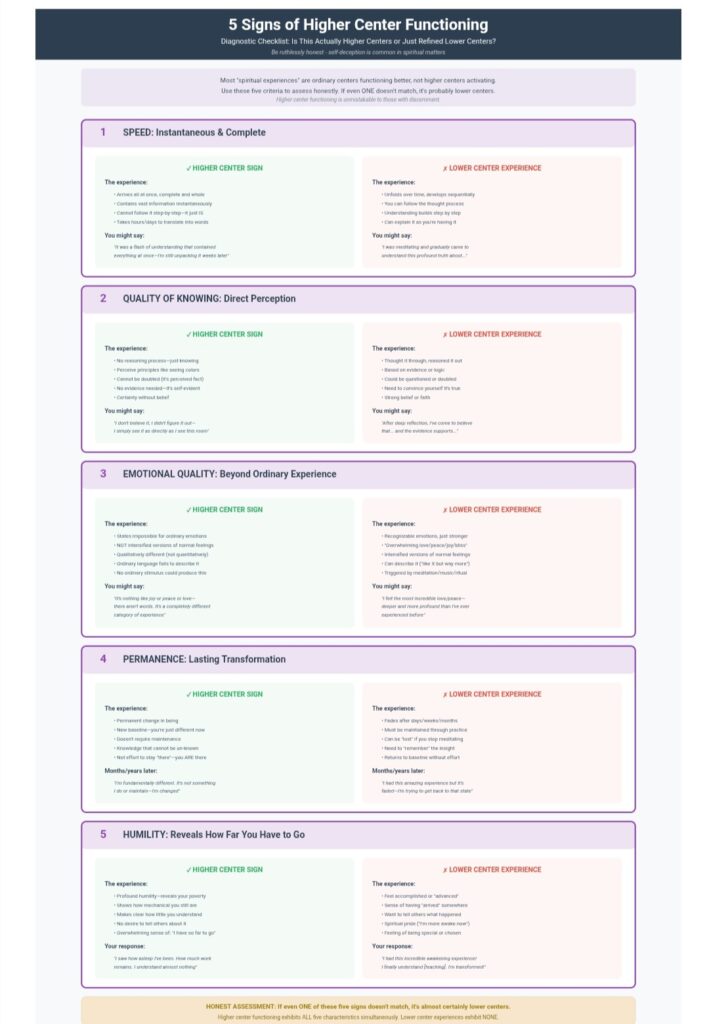
The Fourth Way provides specific criteria.
Sign 1: Extreme Speed
The higher centers operate thousands of times faster than ordinary centers.
A communication from higher emotional or intellectual center may contain enormous amounts of information, appearing in ordinary consciousness as:
- A flash of understanding
- A sudden certainty
- An instantaneous knowing that would take hours to articulate discursively
The test: If an experience unfolds in time, if you can follow it step-by-step, it is probably ordinary centers. Higher center communications arrive complete, all at once.
Sign 2: Direct Knowing Without Reasoning
The higher intellectual center knows directly, without reasoning or evidence.
It does not conclude or deduce but perceives principles the way ordinary consciousness perceives sensory objects.
This is what traditional teachings mean by:
- Direct realization (aparokṣa-jñāna)
- Intellectual intuition
Not guessing or feeling but immediate apprehension of what is.
The test: If you had to think it through, reason it out, or convince yourself, it was ordinary intellectual center. Higher intellectual center produces certainty that cannot be doubted because it is not belief but direct perception.
Sign 3: Qualitatively Different Emotional States
The higher emotional center feels states impossible for ordinary emotional center—not just elevated versions of ordinary emotions but qualitatively different.
Traditional descriptions speak of:
- Ānanda (bliss)
- Agape (divine love)
- Fana (annihilation)
Not pleasure or affection but states the ordinary emotional center cannot produce.
The test: If the emotion is recognizable as an intensified version of ordinary feeling, it is probably ordinary emotional center. Higher emotional center produces what ordinary language cannot adequately describe and what cannot be produced by any ordinary stimulus.
Sign 4: Permanent Transformation
Genuine higher center experiences produce permanent change because they are not experiences in the ordinary sense but changes in the very substances composing consciousness.
The person who has touched higher emotional center exhibits changed emotional being—not through effort or practice but as new baseline.
The person who has received communication from higher intellectual center knows something they cannot un-know.
The test: If the “awakening” requires maintenance, if insight must be repeatedly remembered or the state cultivated, it was probably ordinary centers.
Sign 5: Profound Humility
Genuine higher center experiences produce humility rather than spiritual pride because they reveal the vast gap between ordinary consciousness and what was momentarily accessed.
The person realizes:
- How little they understand
- How mechanical their ordinary functioning is
- How far they have yet to go
The test: Spiritual experiences that produce sense of accomplishment, feeling of being advanced, or desire to tell others what one has realized are almost certainly lower center experiences feeding ego.
Higher center contact reveals one’s poverty, not one’s wealth.
Why Most Spiritual Awakening Claims Are Lower Center Experiences
The contemporary landscape of spiritual awakening—weekend enlightenment intensives, teachers certified after short trainings, books promising instant realization—produces almost entirely lower center experiences that practitioners mistake for higher center activation.
Common Misidentifications
The meditation experience:
- Profound peace when thoughts slow down
- What’s actually happening: ordinary intellectual center trained to function better
- Not: higher intellectual center activation
The devotional experience:
- Overwhelming love during prayer or chanting
- What’s actually happening: refined functioning of ordinary emotional center
- Not: connection with higher emotional center
These Experiences Have Value—But Aren’t Awakening
These experiences are not worthless—they demonstrate that consciousness can function in states more refined than ordinary distraction and reactivity.
But they are not awakening in the sense of higher center activation.
They are better sleep, not waking.
The Problem of Stopping Too Soon
The problem arises when these experiences are mistaken for the real thing and the practitioner stops there, satisfied with refinement of lower centers when transformation of substances remains necessary for access to higher centers.
This explains a perennial observation: many longtime practitioners exhibit refined lower center functioning (calm, articulate, emotionally regulated) while showing no signs of higher center activity (direct knowledge of principles, states of consciousness inaccessible to ordinary awareness, permanent transformation of being).
They have become sophisticated sleepers—their sleep is pleasant, organized, even inspired at times—but they have not awakened.
They can describe awakening eloquently, having read and practiced extensively, but description is not realization.
The Fourth Way’s Ruthless Assessment
The Fourth Way teaching is ruthless about this: you do not have higher centers functioning until you have them functioning, and having them function requires actual transformation of the substances composing your consciousness, not merely interesting experiences or refined thoughts and feelings.
Most people claiming awakening, most teachers teaching awakening, most books describing awakening—all refer to lower center experiences because actual higher center activation is extraordinarily rare, requires years of intensive work, and produces results that cannot be mistaken for anything else by those capable of discernment.
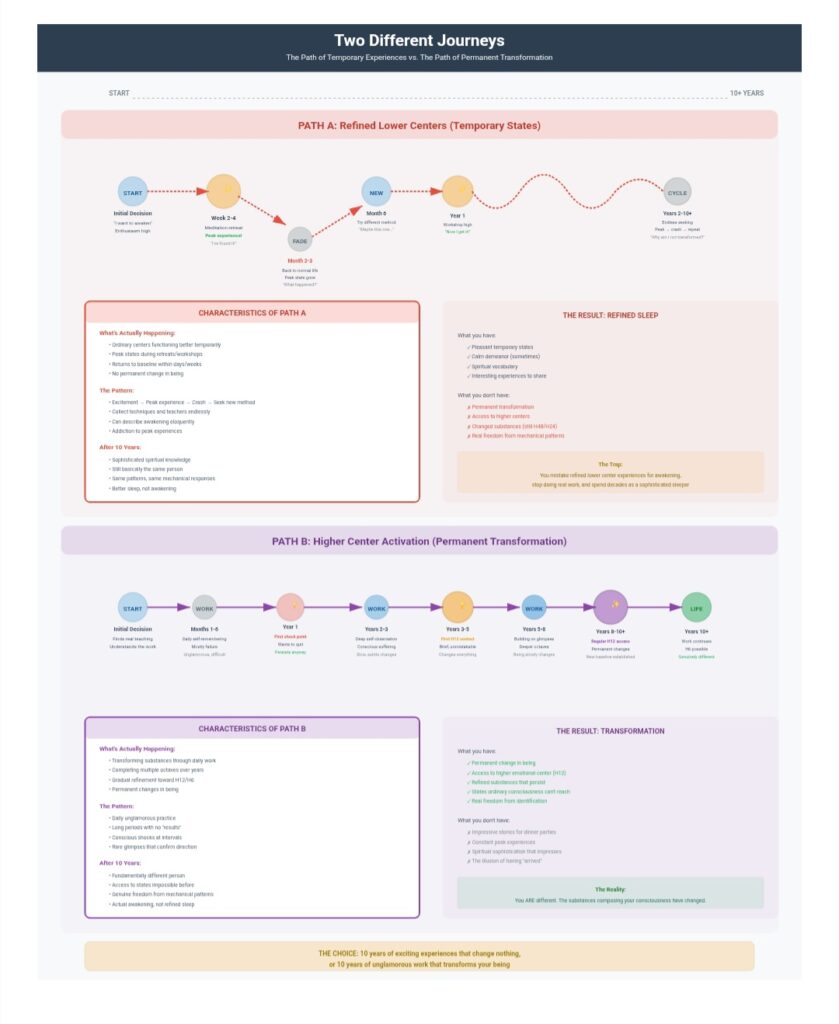
Frequently Asked Questions About Higher Centers
What are the higher centers in Gurdjieff’s teaching?
The higher centers are two dormant levels of consciousness beyond ordinary thinking and feeling: the higher emotional center and higher intellectual center. They operate continuously but remain inaccessible to most humans because ordinary consciousness lacks the refined substances (hydrogens) needed to connect with them.
What is the difference between higher centers and ordinary centers?
Higher centers aren’t refined versions of ordinary consciousness—they’re qualitatively different. They operate thousands of times faster, with finer substances (Hydrogen 12 and 6), and provide access to states of being that ordinary consciousness cannot reach regardless of how elevated its experiences become.
How do you activate the higher centers?
Activation requires transforming the substances that constitute consciousness through:
- Self-remembering (divided attention)
- Conscious suffering (intentional bearing of difficulty)
- Eliminating identification and mechanical imagination
- Consistent practice over years, not weeks or months
There are no shortcuts—the transformation of substances operates on its own schedule.
What is the higher emotional center?
The higher emotional center is what traditions call the soul, psychic being, or spiritual heart. It operates with Hydrogen 12 and produces states qualitatively different from ordinary emotions—not intensified feelings but entirely different states of consciousness impossible for ordinary emotional center to experience.
Can you recognize if your higher centers are functioning?
Yes. Genuine higher center functioning shows specific characteristics:
- Extreme speed of communication (information arrives all at once)
- Direct knowing without reasoning
- Emotional states impossible for ordinary consciousness
- Permanent transformation of being
- Profound humility about how much further one has to go
If an experience requires maintenance or can be lost, it was likely ordinary centers.
How long does it take to activate higher centers?
Years of daily practice may be required for a single genuine contact with the higher emotional center. Decades may be necessary for stable connection with the higher intellectual center. This is not pessimism but accuracy—transformation of substances cannot be rushed.
What are hydrogens in Fourth Way teaching?
Hydrogens are matter at different densities or rates of vibration. Lower numbers indicate finer substances and faster vibrations. Ordinary thoughts operate at H48, ordinary emotions at H24. Higher emotional center requires H12, and higher intellectual center requires H6—substances so much finer that ordinary consciousness cannot connect with them.
Is self-remembering the same as mindfulness?
Self-remembering and mindfulness share similarities but differ in emphasis. Self-remembering specifically aims to create divided attention—simultaneously aware of object and subject—which may produce the finer substances needed to connect with higher centers. Both practices work with presence and non-identification.
Why can’t I access higher centers through meditation alone?
Meditation can refine ordinary centers but doesn’t automatically transform substances. Without specific work on:
- Eliminating identification
- Stopping mechanical imagination
- Conscious suffering to generate transformative friction
- Self-remembering to create divided attention
…the refined substances necessary for higher center connection won’t be produced, regardless of meditation skill.
What’s the difference between higher intellectual center and intelligence?
Intelligence is the capacity of ordinary intellectual center. The higher intellectual center operates entirely differently—it perceives universal principles directly without reasoning, the way you see colors without deducing them. It’s the faculty traditions call Buddhi (direct intellect) or nous (organ of direct knowledge), fundamentally different from ordinary thinking.
Starting the Work Toward Higher Center Activation
Your higher centers exist right now, functioning perfectly and continuously. But you cannot access them through the static of mechanical consciousness—identification, imagination, and self-deception that characterizes ordinary awareness.
Practical Steps to Begin
1. Practice self-remembering daily
- Maintain divided attention throughout ordinary activities
- Be aware of both object and observer simultaneously
- Catch yourself in mechanical consciousness
- Each time you remember you forgot is a moment of remembering
2. Work with conscious suffering
- Choose difficulty rather than comfort when possible
- Maintain presence through friction
- When suffering arises unavoidably, witness it rather than identifying
- Bear discomfort without complaint or dramatization
3. Eliminate mechanical imagination
- Catch the continuous internal cinema
- Notice daydreaming and internal dialogue
- Observe without judgment when you drift
- Return to presence when you notice imagination has captured you
4. Stop lying to yourself
- Observe your mechanical nature without evasion
- See identification, lack of unity, contradictions
- Face truths you habitually avoid
- Direct observation creates possibility for change
5. Study authentic sources
- Read Ouspensky’s In Search of the Miraculous
- Study Gurdjieff’s Beelzebub’s Tales to His Grandson
- Explore traditional metaphysics: Guénon, Coomaraswamy, Aurobindo
- Understand the architecture of being to recognize where you are within it
Set Realistic Expectations
Years of daily practice may be required for a single genuine contact with the higher emotional center.
Decades may be necessary for stable connection with the higher intellectual center.
This timeline contradicts modern desires for instant awakening, but transformation of substances operates on its own schedule, not on ego’s timeline.
The practitioner’s task is creating conditions and then waiting, practicing without expectation of result, working because the work is necessary regardless of outcome.
The Nature of the Work
Most importantly, recognize that you do not currently have higher centers functioning and likely will not for years regardless of practice.
This is not pessimism but accuracy.
The work does not produce quick results because the work is transformation of substances, not accumulation of experiences.
This timeline offends modern sensibility that wants awakening now, on demand, through efficient technique. But transformation occurs on its own schedule, not on ego’s timeline.
What the Work Actually Is
Your higher centers exist. They function perfectly, continuously. But you cannot hear them through the static of identification, imagination, and lying that fills ordinary consciousness.
The work is:
- Clearing that static
- Refining the substances that constitute awareness
- Waiting in case the connection that has always potentially existed momentarily becomes actual
That is all.
It is not dramatic, not exciting, not impressive to others. It is simply the work that might, eventually, allow consciousness to function as it was designed to function rather than remaining trapped in the mechanical sleep that characterizes ordinary human existence.
Related Topics
Fourth Way Practices:
- Self-Remembering Techniques for Beginners
- Working with the Three Centers
- Understanding Conscious vs. Mechanical Suffering
Gurdjieff’s Teaching:
- The Law of Three and Law of Seven
- The Enneagram and Transformation
- Understanding the Ray of Creation
Traditional Metaphysics:
- Guénon on Intellectual Intuition
- States of Being vs. States of Consciousness
- The Doctrine of Subtle Bodies Across Traditions
Practical Development:
- Creating Conditions for Self-Remembering
- Daily Practices for Consciousness Work
- Signs of Progress (and Delusion) in Inner Work

